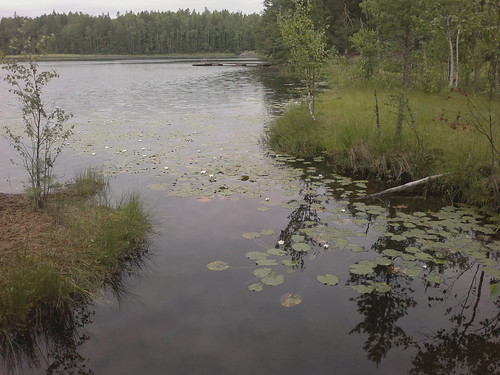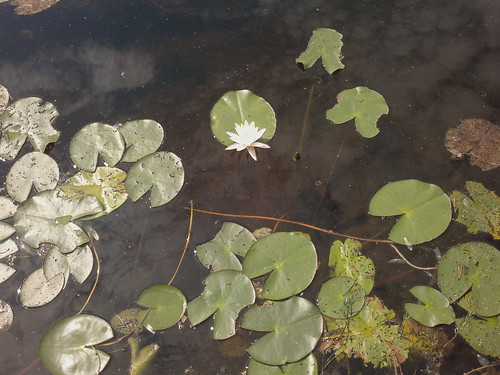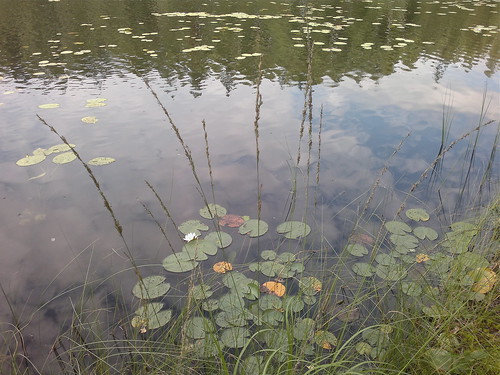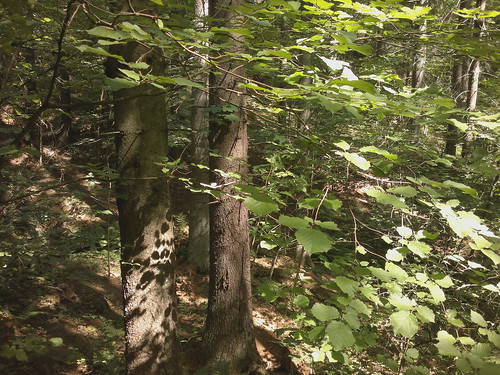Today we walked around the Myllyjärvi lake, one of the several lakes with the same name in Espoo. Weather was nice, cool enough for walking, clouds preventing excessive heat, and wind kept mosquitoes away.
I have continued testing the Nokia E7 camera after the LX3 broke in a thunderstorm. In three days I have taken about 400 photographs with the E7. In some ways the E7 camera is great indeed: it starts up fast (as fast as the LX3), and shoots instantly (there is no focusing delay).
The E7 camera is also very energy-efficient. Even though the battery on the E7 doesn't usually last more than three days (and in normal work use only two days), using the camera doesn't seem to take much juice out of the battery. Several hundreds of photographs can be taken with one charge, at least using my way of shooting: start up the camera, take a couple of photographs in succession, shut down the camera.
Another marvel is the Bluetooth connectivity of the E7. I have been using Bluetooth to transfer hundreds of photographs wirelessly, as I don't have the cable at home, and this hasn't exhausted the battery. I remember the time when transferring photographs wirelessly used to dry up camera phone batteries almost instantly.
But lets go to the bad parts, or maybe ugly is the word. I thought that the E7 is a fixed-focus camera, but it is not so. It is a so-called EDoF camera (Extended Depth of Field).
This is what it means: "EDoF works by using an asymmetrical lens that has the capability to focus objects from different distances, depending on which parts of the lens the various light 'rays' strike, on the same sensor. Internally, this naturally results in an unholy blurred mess, but by using chromatic tricks (using the different optical characteristics of different colour frequencies [...]), by knowing the exact optical properties of the asymmetries in the lens and by using a healthy dose of very clever enhancement electronics, the mess is largely (but not completely) cleared up to produce images that, to the naked eye are pretty clear, whatever the subject, in good light."
The camera module itself does the EDoF processing trick, and only after this happens the the normal image processing pipeline of digital cameras.
In mathematical terms, the optics of an EDoF camera generate an inverse problem in imaging. This happens to be an ill-posed problem - there is no unique solution - so what has to be done is to use a regularization method. In this case it means that the camera electronics have to somehow "guess" what kind of image is hidden in the blurry mess, and generate a result which is somehow optimal in terms of the given constraints.
So, in a way, the E7 camera is the ultimate non-artist's camera: to be able to produce a photograph the camera electronics have to be able to guess in advance the type of the photograph to make sense of the mess. One could even say that only photographs of known types (of fitting into known categories) can be generated with this camera.
Here is some discussion about this: "So objects at different distances have a dynamic influence on the image processing carried out in each individual image. So each image is processed according to the content of the image rather than some generic image processing algorithm."
However, the camera seems to consume very little energy, so this algorithm can't be very complicated. Computationally it is probably comparable to commonly used deconvolution algorithms. So, a very clever thing, but I'm not sure who cares about it - is there a market for such cameras?
As a sidenote, I haven't found much solid facts about the focal length, sensor size, or any other specs of the E7 camera. Several sources have said that the lens is f/2.8 - the same as on the Nokia C6 - which seems to fit my experiences. One source claimed a focal length of 5.3 mm, but I'm not convinced.
Anyway, a fixed length camera with f/2.8 optics and a small sensor probably would normally have a depth of field of about 1.5 meters to infinity, so the EDoF trick doesn't sound extremely impressive, producing a DoF of 0.5 meters to infinity. But in engineering terms this is of course a feat.
What is good about the camera is the fast response, as there is no need for focusing. And the lens is very, very durable, because there are no moving elements.
But in other ways, I don't think this type of camera will be a great success story. Especially as there seems to be quite a lot of compromises needed due to the ill-posed inverse imaging problem.
I think this also explains why some photographs I have taken with the E7 have looked very different from the original view, almost as if someone would have split the image into pieces and performed random surgery on them.
This seems to happen when there are great differences in brightness and objects are randomly distributed either close or far from the camera. At first I thought these were jpeg artifacts due to noise, but they appear even when the sensitivity is set to the lowest setting.
So, if you are interested in taking chiaroscuro photographs in a forest, you may get a surprise with the E7. (Another problem is the limited dynamic range - it is very limited indeed; you have to sacrifice either the dark or the light.)
Also, red color seems to generate problems if there are small pieces of red-colored stuff with varying brightness. Large areas of red don't seem to pose a problem. I noticed this when red shirts of children happened to be in the photograph.
One question which I don't know the answer to is whether the shooting mode of the camera affects the type of regularization method used in the camera module. Would using "landscape" mode produce a different photograph than using "portrait", as an example. Or are these modes affecting just the later stages of image processing?
# 6853 / travel ~ state to state
18 hours ago









1 comment:
pretty pictures showing the untouched nature of Europe
Post a Comment